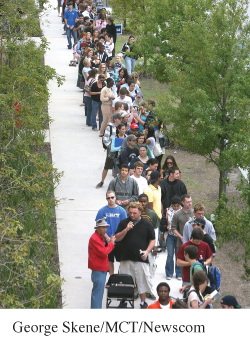Sampling from large populations
Gallup’s sample of 1015 American adults was only 1 out of every 254,200 adults in the United States. Does it matter whether 1015 is 1-in-100 individuals in the population or 1-in-254,200?
Population size doesn’t matter
The variability of a statistic from a random sample is essentially unaffected by the size of the population as long as the population is at least 20 times larger than the sample.
50
Why does the size of the population have little influence on the behavior of statistics from random samples? Imagine sampling soup by taking a spoonful from a pot. The spoon doesn’t know whether it is surrounded by a small pot or a large pot. As long as the pot of soup is well mixed (so that the spoon selects a “random sample” of the soup) and the spoonful is a small fraction of the total, the variability of the result depends only on the size of the spoon.
This is good news for national sample surveys like the Gallup Poll. A random sample of size 1000 or 2500 has small variability because the sample size is large. But remember that even a very large voluntary response sample or convenience sample is worthless because of bias. Taking a larger sample can never fix biased sampling methods.
However, the fact that the variability of a sample statistic depends on the size of the sample and not on the size of the population is bad news for anyone planning a sample survey in a university or a small city. For example, it takes just as large an SRS to estimate the proportion of Arizona State University undergraduate students who call themselves political conservatives as to estimate with the same margin of error the proportion of all adult U.S. residents who are conservatives. We can’t use a smaller SRS at Arizona State just because there were 67,500 Arizona State undergraduate students and more than 258 million adults in the United States in 2013.
51
STATISTICAL CONTROVERSIES
Should Election Polls Be Banned?

Preelection polls tell us that Senator So-and-So is the choice of 58% of Ohio voters. The media love these polls. Statisticians don’t love them because elections often don’t go as forecasted, even when the polls use all the right statistical methods. Many people who respond to the polls change their minds before the election. Others say they are undecided. Still others say which candidate they favor but won’t bother to vote when the election arrives. Election forecasting is one of the less satisfactory uses of sample surveys because we must ask people now how they will vote in the future.
Exit polls, which interview voters as they leave the voting place, don’t have these problems. The people in the sample have just voted. A good exit poll, based on a national sample of election precincts, can often call a presidential election correctly long before the polls close. But, as was the case in the 2004 presidential election, exit polls can also fail to call the results correctly. These facts sharpen the debate over the political effects of election forecasts.
Can you think of good arguments against public preelection polls? Think about how these polls might influence voter turnout. Remember that voting ends in the East several hours before it ends in the West. What about arguments against exit polls?
What are arguments for preelection polls? Consider freedom of speech, for example. What about arguments for exit polls?
For some thought-provoking articles on polls, especially in light of the exit poll failures in the 2004 presidential election, see the following websites:
www.washingtonpost.com/wp-dyn/articles/A47000-2004Nov12.html
www.washingtonpost.com/wp-dyn/articles/A64906-2004Nov20.html
thehill.com/opinion/columnists/dick-morris/4723-those-faulty-exit-polls-were-sabotage
You may also go to www.google.com and search using key words “exit poll failures in the 2004 presidential election.”